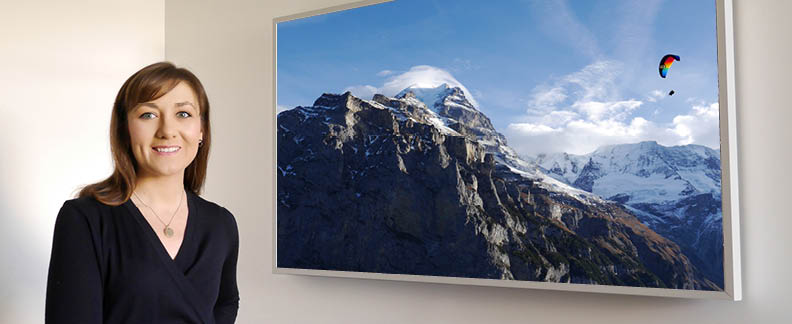Creatively Tackling the New
Kristen Kator ’04 designs for the future.
A big part of her job as a lead designer with Samsung Research America is to look at things as they are now and ask what else they might become. Like flat-screen TVs mounted on walls. Since these sleek devices are already hanging among prized family pictures and framed art, why not turn the TV into a work of art itself? Kator’s team turned an idea into reality with the creation of Samsung’s The Frame TV. Basically, a television when it is on, but a platform for displaying world renowned artwork when it is off.

Kristen Kator looked at her big screen TV and asked, what else could it be? Photos by Kristen Kator.
Picture perfect ideas just keep bubbling up from this Soda Springs, Idaho native. She can’t help herself. She was that kid who loved to color and do artistic things. Luckily, she never grew
out of it. She found a good fit at Utah State University that allowed her to build upon her interest in computer programming and computer graphics. When she graduated in 2004, computer graphics was a relatively new field. It intrigued her to work in a medium in which design and function were so tightly interwoven. In addition to Samsung, she has worked for five other technology and communication giants including British Sky Broadcasting and Sony Corporation of America.
When it comes to technology, Kator is like a horse whisperer for humans. She adopts a sympathetic view of the motives, needs, and desires of those who interact with high-tech to improve the way they experience it. It is her passion, she says. It also happens to be her main creative force—a passion for not only making things, but also making them meaningful.
Here are six other sources that lift her imagination:
1. Be curious.
“That’s definitely what drives me as I work within the tech industry,” she says. “It’s just being really curious about technology itself and thinking about what it can do for people.”
2. Problem solve.
She learned early on from USU’s Alan Hashimoto and Bob Winward that design is really about problem solving. “A lot of people don’t see it that way,” she says. “They see it as making something look nice.” She employs this thinking at home, too. When her husband kept throwing his keys on their new dining set, Kator came up with a design solution by altering the environment with a small entry table by the door with a dish for keys. Problem solved.
3. Brainstorm with abandonment.
Brainstorming with markers and a whiteboard is a great way to coax out creativity, especially if approached from a childlike perspective. “Children are so imaginative, and they don’t judge or put limitations upon themselves,” Kator says. “I have a poster in the office that says ‘do something silly today,’ because I think being open and kind of being silly or being exploratory really helps with your imagination and coming up with new ideas.”
4. Seek inspiration from others.
“Every designer I know has got a gazillion Pinterest boards,” she says. “Certain ideas that you see can help spark other ideas.” When she and colleagues observed mobile behaviors of millennials in one of their research projects it inspired the idea of using a TV screen with a different combination of sources. For example, watch a movie on the left side of the screen while viewing an exercise routine from a phone app on the right side. “Good ideas usually come from a user pinpoint that we find in research and then actually make it into a real product.”
5. Switch things up.
In pre-pandemic days, travel and attending conferences was Kator’s preferred way of stoking creative fires. “People use technology differently in different parts of the world,” she says. “I loved being able to travel to these different places and just be an observer.” When you can’t travel, take walks and do new things, even if it’s just in your backyard. It helps to step away from creative projects and avoid overthinking things. Ideas need to breathe. “It is back-of-the-brain kind of thinking while you go about your daily life,” she says.
6. Be open.
After Kator’s team shared ideas from a brainstorm session for a new product they were met with skepticism from other colleagues. The naysayers said the cost would be too high or ‘you can’t do that because the development team will never agree to it,’ she recounts. The problem with that, she says, is that if you are trying to innovate, you need to keep an open mind and think about what could be without limitations. “The definition of innovation is something new and different. If you’re not thinking about doing things differently, you’re not going to innovate.”





